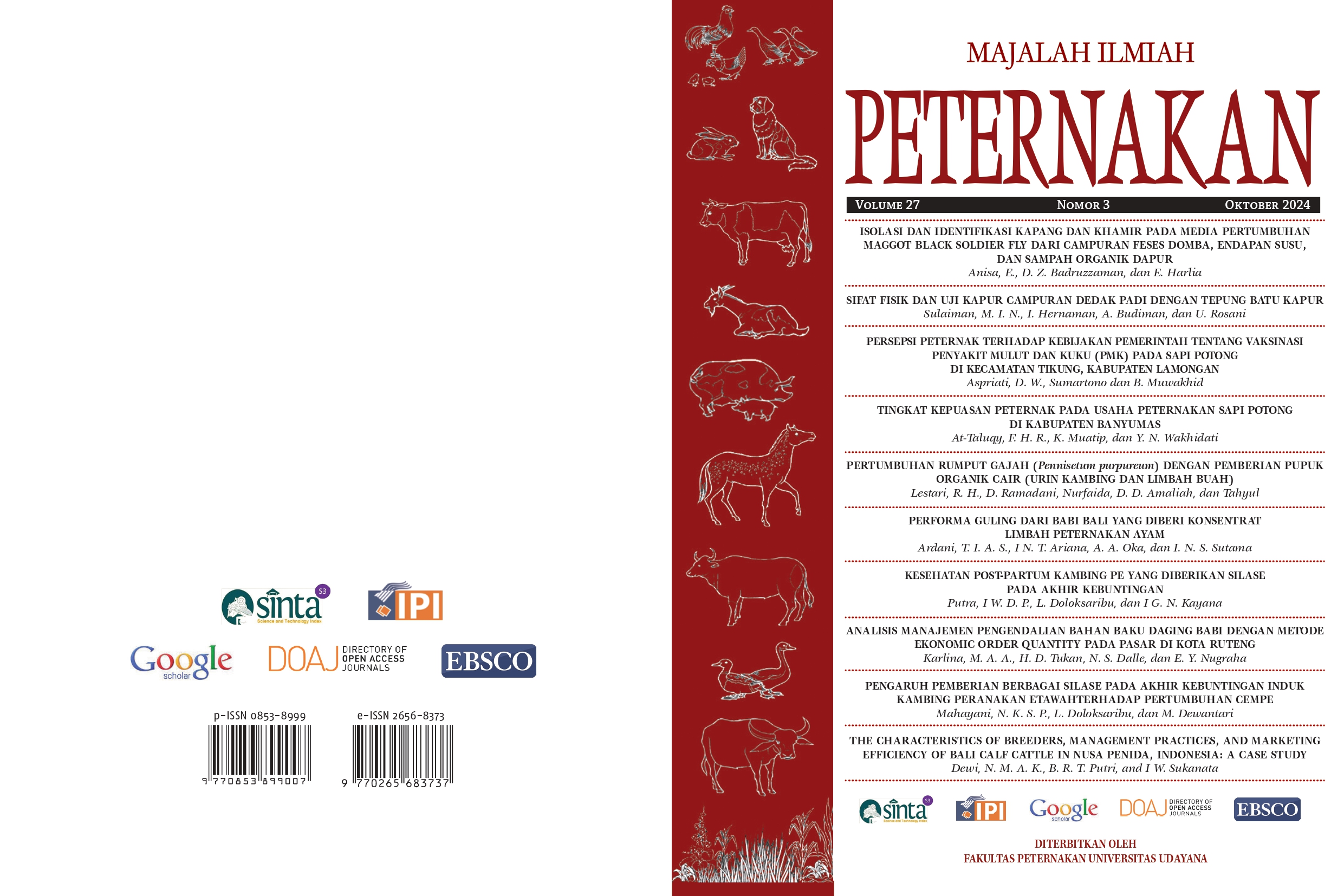ISOLASI DAN IDENTIFIKASI KAPANG DAN KHAMIR PADA MEDIA PERTUMBUHAN MAGGOT BLACK SOLDIER FLY DARI CAMPURAN FESES DOMBA, ENDAPAN SUSU, DAN SAMPAH ORGANIK DAPUR
Abstrak
Feses domba, endapan susu, dan sampah organik dapur berpotensi menjadi media pertumbuhan maggot BSF. Proses degradasi bahan organik oleh maggot BSF dibantu dengan berbagai mikroorganisme. Mikroorganisme yang berperan dalam proses degradasi senyawa organik salah satunya adalah kapang dan khamir. Penelitian ini dila- kukan untuk mengetahui jumlah dan jenis kapang dan khamir yang diperoleh dari media pertumbuhan maggot BSF pada campuran feses domba, endapan susu, dan sampah organik dapur. Penelitian ini menggunakan metode eksperimental dengan data yang dianalisis secara deskriptif. Hasil penelitian menunjukkan bahwa jumlah kapang dan khamir mengalami penurunan. Jumlah rata-rata koloni kapang sebelum degradasi adalah 7,15 x 104 cfu/ml ±1,6 dan sesudah degradasi adalah 2,69 x 104 cfu/ml ± 0,7. Sedangkan jumlah rata-rata koloni khamir sebelum de- gradasi adalah 9,00 x 104 cfu/ml ±2,2 dan sesudah degradasi adalah 3,50 x 104 cfu/ml ±0,5. Kapang yang berhasil diisolasi dan identifikasi pada sampel media maggot diantaranya Aspergillus sp., Cladosporium sp., Mucor sp., Neurospora sp., Penicillium sp., dan Rhizopus sp., sedangkan khamir yang berhasil diisolasi dan identifikasi pada sampel media maggot BSF diantaranya Candida sp., Saccharomyces sp., dan Zygosaccharomyces sp.
##plugins.generic.usageStats.downloads##
Referensi
Beuchat, L. R., F. Copeland, M. S. Curiale, T. Danisavich, V. Gangar, B. W. King, T. L. Lawlis, R. O. Likin, J. Okwusoa, C. F. Smith, and D. E. Townsend. 1998. Comparison of the SimPlateTM total plate count method with PetrifilmTM, RedigelTM, and conven- tional pour-plate methods for enumerating aerobic microorganisms in foods. Journal of Food Protec- tion. 61(1): 14-18.
Boekhout, T. and E. Guého. 2003. Basidiomycetous yeasts. In: Howard, D.H. (Ed.), Pathogenic Fungi in Humans and Animals (seconded). Marcel Dekker, Basel. 551–574.
Bosch, G., S. Zhang, G. Dennis, and H. H. Wouter. 2014. Protein quality of insects as potential ingredients for dog and cat foods. Jurnal NutrSci. 3: 1-4.
Cheng, A., Y. Hsin, and W. T. Lin. 2014. Effects of mold growth on building materials by different environ- ments in Taiwan. Journal of Civil Engineering, 18(2): 1083-1090.
Creegan, E. F., R. Flynn, G. Torell, C. E. Brewer, D.V. Leeuwen, R. N. Acharya, R. J. Heerema, and M. Darapuneni. 2022. Pecan (Carya illinoinensis) and dairy waste stream utilization properties and economics of on-farm windrow systems. Sustain- ability, 14(5): 1-13.
Dani, I. R., A. W. N. Jarmuji, Pratma, and D. A. Nugraha.
2017. Kolaborasi Messessaba (Media Feses Sapi dan Feses Domba) terhadap respon cacing tanah (Pheretima Sp). Jurnal Sains Peternakan Indone- sia. 12(3): 308-316.
Hamber, R. 1997. Chapter V-1 - Fungi: Identification. Manual of Techniques in Insect Phatology. 153-185. Harris, J. 1986. Modified method for fungal slide culture.
Journal of Clinical Microbiology. 24(3): 460-461. Kluber, P., S. Muller, J. Schmidt, H. Zorn, and M. Ruhl. 2022. Isolation of bacterial and fungal microbiota associated with Hermetia illucens larvae reveals novel insights into entomopathogenicity. Microor-
ganism. 10(3): 1-19.
Mahardika, W. A., D. Romario, M. F. Q. Naufal, R. Warih,
and T. L. Arina. 2022. Isolation and characteriza- tion of mold on furniture in biological laboratory environment using contact plate method. Journal Tropic Biology. 22(3): 765-772.
Mahmud, M. D. R. 2013. Isolation and identification of fungal species from bio-compost. Advances in Life Sciences. 2(1): 85-88.
Marlina E. T. 2007. Kandungan Gizi Endapan Susu PT In- domilk. Laboratorium Nutrisi Ternak Ruminansia dan Kimia Makanan Temak. Fakultas Peternakan Universitas Padjadjaran, Sumedang.
Mirwandono, E., M. Sitepu, T. H. Wahyuni, Hasnudi, N. Ginting, A. W. Siregar, and Sembiring. 2017. Nut- rition quality test of fermented waste vegetables by bioactivator local microorganisms (Mol) and effecti- ve microorganism (EM4). Earth and Environmant Sciece. 122(1): 524-529.
Purnamasari, D. K., M. Ariyanti, Syamsuhaidi, Sumiati, dan Erwan. Potensi sampah organik sebagai media tumbuh maggot Black Soldier Fly (Hermetia illu- cens). 2021. Jurnal Ilmu dan Teknologi Peternakan Indonesia. 7(2): 95-106.
Raimondi, S., G. Spampinato, L. L. Macavei, L. Lugli, F. Candeliere, M. Rossi, L. Maistrello, and A. Amaret- ti. 2020. Pengolahan sampah organik pasar effect of rearing temperature on growth and microbiota composition of Hermetia illucens. Microorganisms. 8(6): 1-13.
Rosana, Y., T. Matsuzawa, T. Gonoi, and K. Anis. 2014. Modified slide culture method for faster and easier identification of Dermatophytes. Microbiology. 8(3): 135-139.
Saleh, M., V. D. Paramita, dan M. Syahrir. 2022. Pembu- atan pupuk organik cair dengan metode fermentasi teraduk secara kontinyu. Prosiding Seminar Nasi- onal Penelitian dan Pengabdian Kepada Masya- rakat. 127-131.
Sarpong, D., S. O. Kwarteng, S. F. Gyasi, R. Buamah, E. Donkor, E. Awuah, and M. K. Baah. 2019. Biode- gradation by composting of municipal organic solid waste into organic fertilizer using the Black Soldier Fly (Hermetia illucens) (Diptera: Stratiomyidae) Larvae. Journal of Recycling of Organic Waste in Agriculture. 8(2): 45-54
Setiawan, F., E. Harlia, dan Y. A. Hidayati. 2023. Peran maggot sebagai detritvor dalam pengolahan limbah dan ternak unggas. Jurnal Teknologi Hasil Peter- nakan. 4(2): 213-21.
Setti, L., E. Francia, A. Pulvirenti, S. Gigliano, M. Zac- cardelli, C. Pane, F. Caradonia, S. Bortolini, L. Maistrello, and D. Ronga. 2019. Use of Black Soldier Fly (Hermetia illucens (L.), Diptera: Stratiomyidae) larvae processing residue in peat-based growing media. Waste Management. 95(2): 278-288.
Siddiqui, S. A., B. Ristow, T. Rahayu, N. S. Putra, N. W. Yowono, K. Nisa, B. Mategeko, S. Smetana, M. Saki, A. Nawaz, and A. Nagdalian. 2022. Black Soldier Fly Larvae (BSFL) and their affinity for organic waste processing. Waste Management. 140(2): 1-13.
Singh, A. K. Kumari. 2019. An inclusive approach for organic waste treatment and valorisation using Black Soldier Fly larvae: A review. Journal of En- viromental Management. 251(1): 1-13.
Sundarta, I, Y. S. Atika, dan P. W. Hendra. 2018. Pe- ngelolaan sampah organik menjadi kompos melalui pembuatan tong super. Jurnal. 2(3): 1-5.
Suryani, Y., O. Taupiqurrahman, dan Y. Kulsum. 2020. Mikologi. PT. Freeline Cipta Granesia. Padang.
Thapa, S., R. Shrestha, A. Tirewa, A. Sharma, and K. C. Yuvraj. 2015. Isolation of yeast from soil and dif- ferent food samples and its characterization based on fermentation. Nepal Journal of Biotechnology. 3(1): 29-34.
Trama, B., J. D. S. Fernandes, G. Labuto, J. C. F. de Oliveira, C. V. Niero, R. C. Pascon, and M. A. Vallim. 2014. The evaluation of bioremediation potential of a yeast collection isolated from composting. Ad- vances in Microbiology. 4(12): 1-11.
Walker, G. M. 2015. Pichia anomala: Cell physiology and biotechnology relative to other yeasts. Antonie Van Leeuwenhoek. 99(1): 25-34.
Wang, Y. S. M. and Shelomi. 2017. Review of Black Soldier Fly (Hermetia illucens) as animal feed and human food. Food. 6(10): 91.
Xu, L., M. L. Ntakatsane, X. Wang, and Meng. 2021. Im- proved sensitive fluorescent/visible dual detection count plate for mold and yeast in food. Journal of AOAC International. 128(4): 54-60.
Zakova, M. M, and Borkovcova. 2014. Hermetia illucens application in management of selected types of organic waste. The 2nd Electronics International Interdisciplinary Conference. 2(6): 367-370.






